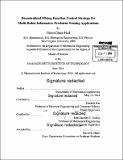Decentralized mixing function control strategy for multi-robot informative persistent sensing applications
Author(s)
Hall, Gavin Chase
DownloadFull printable version (14.23Mb)
Other Contributors
Massachusetts Institute of Technology. Department of Mechanical Engineering.
Advisor
Daniela Rus and Jean-Jacques E. Slotine.
Terms of use
Metadata
Show full item recordAbstract
In this thesis, we present a robust adaptive control law that enables a team of robots to generate locally optimal closed path persistent sensing trajectories through information rich areas of a dynamic, unknown environment. This controller is novel in that it allows the robots to combine their global sensor estimates of the environment using a mixing function to opt for either: (1) minimum variance (probabilistic), (2) Voronoi approximation, or (3) Voronoi (geometric) sensing interpretations and resulting coverage strategies. As the robots travel along their paths, they continuously sample the environment and reshape their paths according to one of these three control strategies so that ultimately, they only travel through regions where sensory information is nonzero. This approach builds on previous work that used a Voronoi-based control strategy to generate coverage paths [32]. Unlike the Voronoi-based coverage controller, the mixing-function-based coverage controller captures the intuition that globally integrated sensor measurements more thoroughly capture information about an environment than a collection of independent, localized measurements. Using a non-linear Lyapunov function candidate, we prove that the robots' coverage path configurations converge to a locally optimal equilibrium between minimizing sensing error and path length. A path satisfying this equilibrium is called an informative path. We extend the informative path controller to include a stability margin and to be used in conjunction with a speed controller so that a robot or a group of robots equipped with a finite sensing footprint can stabilize a persistent task by maintaining all growing fields within the environment bounded for all time. Finally, we leverage our informative persistent paths to generate a dynamic patrolling policy that minimizes the distance between instantaneous vehicle position and incident customer demand for a large fleet of service vehicles operating in an urban transportation network. We evaluate the performance of the policy by conducting large-scale simulations to show global stability of the model and by comparing it against a greedy service policy and historical data from a fleet of 16,000 vehicles.
Description
Thesis: S.M., Massachusetts Institute of Technology, Department of Mechanical Engineering, 2014. Cataloged from PDF version of thesis. Includes bibliographical references (pages 119-121).
Date issued
2014Department
Massachusetts Institute of Technology. Department of Mechanical EngineeringPublisher
Massachusetts Institute of Technology
Keywords
Mechanical Engineering.